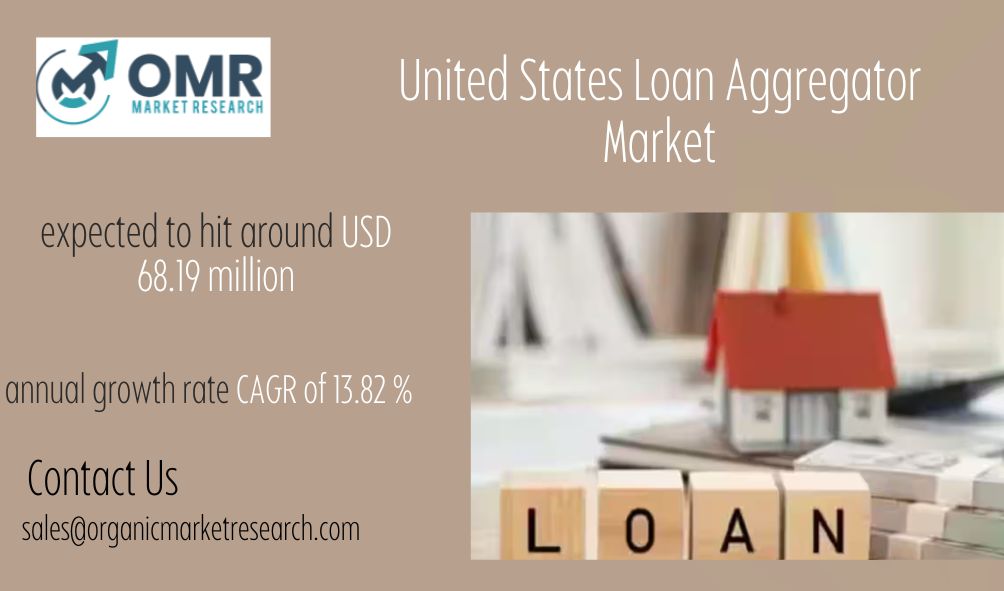United States Loan Aggregator market size was USD 21.27 million in 2023 and the market is projected to touch USD 68.19 million by 2032, at a CAGR of 13.82 % during the forecast period. Loan Aggregator is a sector where companies collect information on different loan options from various lenders like banks, credit unions, and online lenders. This information is then presented to consumers in a centralized location. Basically, these aggregators serve as middlemen between those seeking loans and potential lenders, simplifying the process of comparing loan terms, interest rates, and other details without having to go to multiple lenders separately.
Recently, the loan aggregation market in the United States has seen a big uptick in growth. This is largely due to the growing need for convenience and transparency when applying for loans. People like being able to find a variety of loan options all in one place, which saves them time and hassle in their search for the right financing. Furthermore, loan aggregators often use technology to make the application process smoother, providing online tools and resources that make it easier to compare and apply for loans. The demand for easy and convenient financing options is on the rise, with more borrowers turning to user-friendly methods to secure loans for personal, mortgage, and small business needs. As the industry grows, competition among loan aggregators is set to increase, leading to more innovation and improvements in the borrower experience.

United States Loan Aggregator report scope and segmentation.
United States Loan Aggregator dynamics
The loan aggregator market in the United States is influenced by several factors such as technological advancements, regulatory changes, and shifts in consumer preferences. Technology plays a key role in driving market growth as loan aggregators invest in digital platforms and data analytics to improve their services and enhance user experience. These innovations allow borrowers to easily access loan information and enable smooth communication between lenders and applicants.
Furthermore, changes in regulations can have a big impact on the Loan Aggregator market, as policymakers want to make sure consumers are protected and lending practices are fair. It is crucial for loan aggregators to follow rules like the Truth in Lending Act (TILA) and the Equal Credit Opportunity Act (ECOA) to keep the trust of both borrowers and lenders. Moreover, shifts in interest rates, economic factors, and consumer habits can also change how the market operates and impact the need for loan aggregation services. In order to thrive in a constantly changing market, companies within this industry need to be flexible and quick to react to outside influences. They should be open to new ideas and technologies while still following laws and rules to keep up their growth and stay ahead of the competition.
United States Loan Aggregator drivers
Changing Consumer Behaviour
Changes in how consumers behave are a big factor driving the Loan Aggregator market in the United States. As more people get used to managing their finances online and looking for digital options, the need for easy-to-use loan comparison sites goes up. On top of that, younger generations like Millennials and Gen Z are more likely to adopt technology-driven solutions and feel at ease using online financial services. The increasing number of people using digital tools presents a chance for companies that bring together loans to take advantage of the preferences of customers. By providing easy-to-use websites, mobile apps, and customized suggestions that cater to the specific needs and tastes of various demographic groups, loan aggregators can tap into this trend.
Increasing Demand for Convenience
The increased need for convenience from borrowers is a key factor driving the Loan Aggregator market in the United States. In our busy society, people want easy and efficient processes that help save time and energy. Loan aggregators provide a convenient solution, giving borrowers access to a range of loan options from different lenders all in one place. This means they don’t have to go to multiple banks or financial institutions separately. This convenience not only attracts more borrowers to use loan aggregation services but also encourages loyalty among current users who appreciate the simplicity and effectiveness of the system.
- Restraints:
Regulatory Compliance Challenges
Complying with regulations is a big challenge for the US Loan Aggregator market. Financial services must follow stringent guidelines to protect consumers and promote fair lending. Loan aggregators need to understand laws like the Truth in Lending Act (TILA) and the Equal Credit Opportunity Act (ECOA). Meeting these regulations takes a lot of time and money, and not following them can lead to legal trouble and harm a company’s reputation. This limits the potential for growth and profit in the loan aggregation industry.
Cybersecurity Risks
In the United States, the Loan Aggregator market faces challenges from cybersecurity threats. As financial services continue to go digital, loan aggregators are at risk of cyber-attacks that aim to steal personal and financial information from customers. Any breach of data or security incident not only hurts consumer trust but can also lead to penalties and financial harm for loan aggregators.
- Opportunities:
Expansion into Niche Markets
A major opportunity for the US Loan Aggregator market lies in tapping into niche markets. Instead of just offering mainstream loan products like personal loans and mortgages, there is a rising need for specialized financing options that cater to specific demographics or industries. By focusing on niche markets such as small business loans, student loans, or green financing, loan aggregators can reach overlooked segments and stand out from rivals. This way, they can grow their customer base and increase revenue streams.
- Segment Overview
By loan type, the market is segmented into include Credit Cards, Auto Loans, Home Loans, Personal Loans, and SME/Commercial Loans. Credit card aggregation, is about giving consumers a clear picture of different credit card choices. This includes details on rewards, interest rates, and fees, so people can pick the card that fits their spending habits and financial aspirations best. Auto loan aggregation streamlines the process of comparing financing options for buying vehicles. This gives borrowers access to various lenders offering competitive rates and terms. Home loan aggregation helps homebuyers compare mortgage options. This includes fixed-rate and adjustable-rate mortgages, FHA loans, and VA loans, so they can find the right financing solution for their dream home. Regarding personal loans, there are many options available for borrowers. This includes debt consolidation loans, medical loans, and wedding loans that offer flexibility without the need for collateral. SME and commercial loans connect small and medium-sized enterprises with lenders providing business loans, lines of credit, and equipment financing to support entrepreneurship and business growth.
By mode of operations, the market is segmented into Offline and Online. Offline loan aggregation, borrowers usually go to physical offices or use intermediaries to help them compare loan options and fill out applications by hand. This old-fashioned method gives a personal touch and allows for in-person communication, but it cannot be as convenient or efficient as online platforms. In contrast, online loan aggregation uses digital tools and websites to give borrowers quick access to loan details, comparison features, and application processes from any device with internet connection. Online loan comparison websites provide more convenience, speed, and accessibility, enabling borrowers to easily compare and apply for loans from various lenders at any time and from any location, eliminating the need for in-person visits to multiple lenders. The shift towards online operations caters to the changing preferences of consumers towards digital banking and financial services, fuelling the expansion of the Loan Aggregator market by delivering smooth and customer-centric experiences that meet the requirements of contemporary borrowers.
United States Loan Aggregator Overview by Region
The market for loan aggregation in the United States shows different patterns depending on the region, including market trends, what consumers prefer, and the regulations in place. In big cities like New York City, Los Angeles, and Chicago, where there are many banks and a diverse population, people are looking for loan aggregation services that are easy to use and offer competitive loan options. These cities are important centres for new ideas and digital advancements in the financial industry, drawing in both established companies and new fintech startups looking to take advantage of the increasing interest in online lending solutions. On the other hand, rural areas and regions with lower population density might not embrace loan aggregation platforms as quickly because of a lack of reliable internet access and a preference for traditional banking methods. Still, efforts to improve broadband access and enhance financial inclusion are narrowing this gap, opening up possibilities for market expansion in underserved communities. State regulations also differ, with some areas imposing stringent supervision on financial service providers, such as loan aggregators, to safeguard consumer interests and ensure fair lending practices.
United States Loan Aggregator market competitive landscape
Key incumbents in the market include well-known loan aggregation platforms such as LendingTree, Bankrate, and Credit Karma, which leverage extensive networks of lenders and advanced technology to offer borrowers a wide range of loan options and competitive rates. Additionally, fintech start-ups like SoFi and Rocket Mortgage are disrupting the industry with innovative approaches to loan aggregation, focusing on user experience, digitalization, and personalized financial solutions. Old-school banks and credit unions are also major players in the competition, using their well-known brands and loyal customers to provide loan aggregation services along with other banking products. Customers are looking for easier digital experiences, so loan aggregator platforms are focusing more on user-friendly interfaces and mobile accessibility to stay competitive. The emphasis on technology, along with personalized financial advice and new lending products, shows how the US Loan Aggregator market is always changing and improving.
United States Loan Aggregator Recent Developments
- March 2023, farm banks in the United States saw a notable 8.1% rise in 2022, reaching $103.1 billion, as reported by the American Bankers Association’s annual Farm Bank Performance Report. The increase was primarily driven by a 9.7% surge in outstanding loans secured by farmland and a 5.9% uptick in agricultural production loans.
Scope of United States Loan Aggregator report
In case you don’t find what, you are looking for, please get in touch with our custom research team at
Latest Report
https://organicmarketresearch.com/europe-agricultural-microbials-market
https://organicmarketresearch.com/europe-electric-two-wheeler-market
https://organicmarketresearch.com/gcc-construction-machinery-market
https://organicmarketresearch.com/saudi-arabia-loan-aggregator-market
Contact Us
+91 9319642100
sales@organicmarketresearch.com
Noida One Tower Sec 62 Noida 201301
Website: https://organicmarketresearch.com













